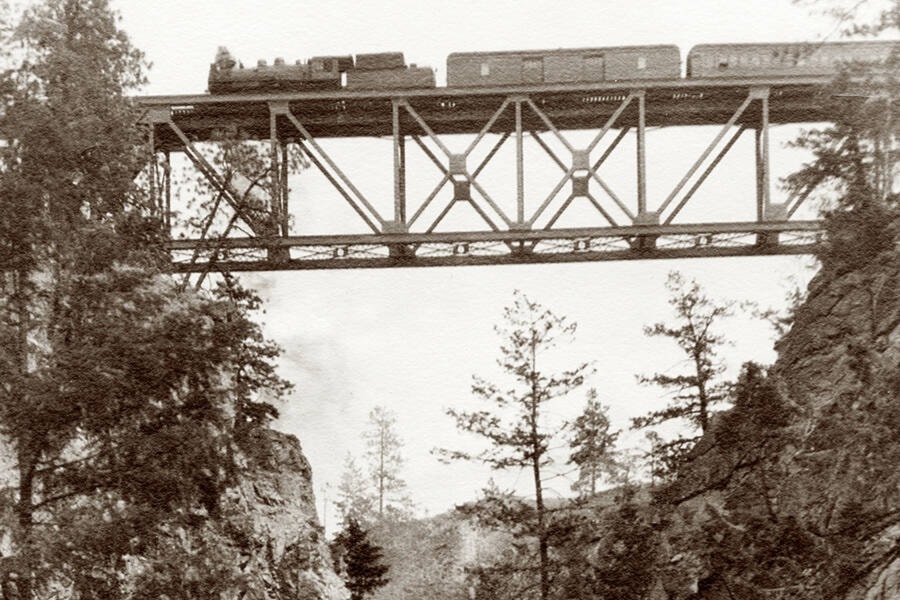At the turn of the 19th century, the Canadian Pacific Railway often drove the growth of communities, and at times stymied the growth of others. Routing decisions were unpredictable and opaque, creating the impression they were based on the whim of the railroad barons.
The Nicola Valley was one of many hotbeds of activity in British Columbia before 1900. Mines operated both north and south of Nicola Lake, extracting gold, silver and copper. The town of Nicola was the primary commercial center in the valley in the 1890s. In 1905, it still had a newspaper, several retail stores, a hotel, a bank and more.
Meritt became increasingly important from 1900 onward. The town was named for William Meritt, an able promoter. He prospected for coal near the future site of Meritt in 1891, and found it. Meritt recognized the opportunity for a railway to transport the coal. So, he revived the Nicola, Kamloops and Similkameen Railway (NC&S) charter in 1903, and began to build a line from Spences Bridge on the CPR mainline to Meritt. The CPR soon leased the charter and completed the line in 1906.
The CPR also ran a line to Nicola, and designated it a division point on a future line to Midway in the Boundary Country, but Nicola was destined to fade away. Meritt became a force in coal mining, and rail. Most rail traffic in the valley ran to or from Meritt. The CPR within a few years advanced from Meritt, while Nicola lingered at the end of an underused spur line. Retail and government offices began to move from Nicola to Meritt mid-decade. The Meritt Herald and Bank of Montreal followed.
The Nicola Valley has a long history of ranching. The roots extend back to 1872, when John Douglas homesteaded on Douglas Lake. In 1884, Douglas sold his property to Charles Beak and his partners. Beak had previously been a very successful rancher in the Cariboo. Beak’s group established the Douglas Lake Ranch, which grew ultimately to become the largest in Canada.
Joseph Guichon arrived in British Columbia during the Cariboo Goldrush. He soon soured on mining, and began working on various ranches in the Cariboo, and eventually on his own ranch. When Guichon sold that property, he acquired ranch lands in the Quilchena, northeast of present-day Meritt, in 1884. He established and expanded the historic Quilchena Ranch, and his wealth.
In 1907, he began to build the substantial, elegant Quilchena Hotel. It opened in 1908. Guichon, a sophisticated investor, certainly would not have built this hotel in this location only to serve local ranch hands and miners. It was too fine – and too costly to construct – for that purpose alone.
A railway had long been expected in Quilchena. Indeed, the NK&S was originally formed in 1891 to link the town of Nicola through Quilchena with Kamloops, and gain access to the CPR mainline. The charter lapsed, and when William Meritt reestablished it, he had no intent to link with Kamloops, and nor did the CPR when they assumed control.
The CPR, though, did plan to extend the line from Nicola to Quilchena and then south to Aspen Grove. Successive issues of the Nicola Herald followed the survey of that route from 1906 to 1907. In 1908, however, it became clear that the CPR was having some doubts about the route.
The CPR began a survey from Meritt directly to Aspen Grove along the Coldwater River. In June of 1909, a notice in the Herald informed that the CPR had provided a plan to the province, “showing the first section (thirty miles) of the proposed extension of the [NK&S] from Merit to Similkameen….”
The Herald wrote that the railway, “is to be built along the Coldwater Survey.” With that, any hopes of a railroad for the Quilchena vanished. Joseph Guishon’s splendid new hotel would not attract the railroad patrons that he had expected, and he would have to rely upon local clientele to sustain it.
There have been major challenges since, including a four decade closure from 1917 to 1958. Yet, the hotel, 115 years later, is intact and pristine. The period architecture, decor and ambience are all firmly in place.
The CPR later ceded the operation of the Nicola subdivision to its subsidiary, the Kettle Valley Railroad. Barry Sanford’s book on the KVR, McCulloch’s Wonder, is a compelling read, particularly a haunting passage describing the long wait for the railroad that did not arrive. It’s poetic!
“The Quilchena Hotel also remains, with Joseph Guishon’s portrait still hanging by the staircase just as it did a century ago. … It is a magnificent heritage preserved in suspended animation, untouched by the passage of so many years. Perhaps – just perhaps – it is still waiting for the railway that will now never come.”
____
Bruce Uzelman, based in ��������, holds interests in British Columbia history as wells as current political and economic issues.
Bruce had a career in small business, primarily restaurant and retail. He holds a Bachelor of Arts, Advanced from the University of Saskatchewan, with Majors in Political Science and Economics.
Contact: urban.general@outlook.com



